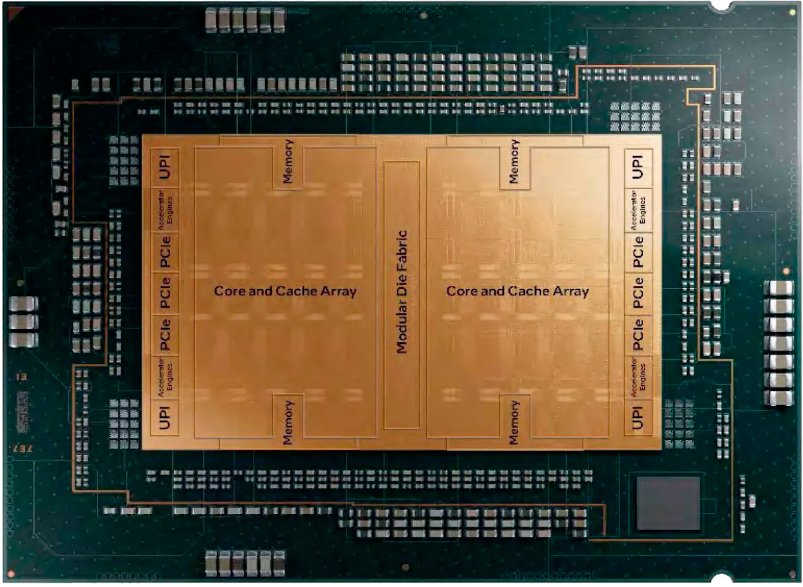|
Back to all articles
Emerald Rapids: Intel's Next Leap in Server Power
Published: 12-19-2023 
Image credit: Intel)
Intel is gearing up to make a big splash in the server market with its 5th Generation Xeon processors, codenamed Emerald Rapids. These chips are set to redefine performance benchmarks, and here's why we think every tech enthusiast should be excited.
More Cores, More PowerEmerald Rapids is pushing the limits with up to 64 cores and 320MB of L3 cache, offering better performance per watt compared to its predecessor, Sapphire Rapids. This means more efficient processing power, which is a key concern in today's energy-conscious world with data centers a major target of criticism.
Sure, we’ve seen higher core counts before, but it looks like Intel is promising a 20-30% per-core improvement in tasks such as Java code execution, media transcoding, and High-Performance computing tasks (e.g. LAMMPS).
AI-Ready PerformanceEquipped with built-in AI accelerators and Intel Advanced Matrix Extensions (Intel AMX), Emerald Rapids is poised to deliver significant performance uplifts in AI processing.
AI is the buzzword on everyone’s lips, and with chatbots and other high-end AI applications flooding the market, AI-acceleration compute power is in high-demand. These AMX extensions promise between 1.3x and 2.4x the performance of the previous generation. This could in fact be the killer performance uplift that really gets those upgrades going in data centers.
Faster, Smoother ConnectivityEmerald Rapids supports higher native DDR5 and has an enhanced Ultra Path Interconnect (UPI), promising quicker data transfer and processing.
We don’t know exactly what new higher speeds of DDR5 these CPUs will have, but this and the faster interconnects mean more bandwidth. You can never have enough bandwidth when you’re packing this many cores into a single CPU. A Compact PowerhouseEmerald Rapids features a two-die design, a shift from the four-die design of Sapphire Rapids. This compact design leads to potentially smaller overall area and improved latency. The increase in L3 cache to 5MB per core should allow for efficient handling of large data volumes. That’s a big upgrade over Sapphire Rapids and it’s also why these CPUs promise to have that whopping 320MB cache count.
A Range for Every NeedFrom the Xeon Platinum 8593Q to the entry-level Xeon Silver, Emerald Rapids offers a processor for every server need. And with drop-in compatibility with Intel's Eagle Stream platform, upgrading should be a cost-effective breeze for existing Intel users. While this is still unconfirmed, here’s what the range will likely be:
Xeon Platinum 8593Q: 64 Cores, 128 Threads, 2.20 GHz Base Clock, 320 MB L3 Cache Xeon Platinum 8592: 64 Cores, 128 Threads, 1.90 GHz Base Clock, 320 MB L3 Cache Xeon Platinum 8592V: 64 Cores, 128 Threads, 2.00 GHz Base Clock, 320 MB L3 Cache Xeon Platinum 8581V: 60 Cores, 120 Threads, 2.00 GHz Base Clock, 300 MB L3 Cache Xeon Platinum 8580: 60 Cores, 120 Threads, 2.00 GHz Base Clock, 300 MB L3 Cache Xeon Platinum 8571N: 60 Cores, 120 Threads, 2.40 GHz Base Clock, 300 MB L3 Cache Xeon Platinum 8570: 60 Cores, 120 Threads, 2.10 GHz Base Clock, 300 MB L3 Cache Xeon Platinum 8568Y: 60 Cores, 120 Threads, 2.30 GHz Base Clock, 300 MB L3 Cache Xeon Platinum 8562Y: 12 Cores, 24 Threads, 2.80 GHz Base Clock, 60 MB L3 Cache Xeon Platinum 8558: 52 Cores, 104 Threads, 2.10 GHz Base Clock, 260 MB L3 Cache Xeon Platinum 8558P: 52 Cores, 104 Threads, 2.70 GHz Base Clock, 260 MB L3 Cache Xeon Platinum 8558U: 52 Cores, 104 Threads, 2.00 GHz Base Clock, 260 MB L3 Cache Xeon Gold 6558Q: 12 Cores, 24 Threads, 3.20 GHz Base Clock, 60 MB L3 Cache Xeon Gold 6554S: 36 Cores, 72 Threads, 2.20 GHz Base Clock, 180 MB L3 Cache Xeon Gold 6548Y: 12 Cores, 24 Threads, 2.50 GHz Base Clock, 60 MB L3 Cache Xeon Gold 6548N: 12 Cores, 24 Threads, 2.80 GHz Base Clock, 60 MB L3 Cache Xeon Gold 6544Y: ? Cores, ? Threads, 3.60 GHz Base Clock, 45 MB L3 Cache Xeon Gold 6542Y: 12 Cores, 24 Threads, 2.90 GHz Base Clock, 60 MB L3 Cache Xeon Gold 6538Y: 12 Cores, 24 Threads, 2.20 GHz Base Clock, 60 MB L3 Cache Xeon Gold 6538N: 12 Cores, 24 Threads, 2.10 GHz Base Clock, 60 MB L3 Cache Xeon Gold 6534: ? Cores, ? Threads, 3.90 GHz Base Clock, 22.5 MB L3 Cache Xeon Gold 6530: 32 Cores, 64 Threads, 2.10 GHz Base Clock, 160 MB L3 Cache Xeon Gold 6526Y: ? Cores, ? Threads, 2.80 GHz Base Clock, 37.5 MB L3 Cache Xeon Gold 5520: ? Cores, ? Threads, 2.20 GHz Base Clock, 52.5 MB L3 Cache Xeon Gold 5515: ? Cores, ? Threads, 3.20 GHz Base Clock, 22.5 MB L3 Cache Xeon Gold 5512U: ? Cores, ? Threads, 2.10 GHz Base Clock, 52.5 MB L3 Cache Xeon Silver 4516Y: ? Cores, ? Threads, 2.20 GHz Base Clock, 45 MB L3 Cache Xeon Silver 4514Y: 6 Cores, 12 Threads, 2.00 GHz Base Clock, 3 MB L3 Cache
(Note: '?' indicates unspecified or unknown details for certain models.)
We’re pretty excited at Titan to see what the final form of Emerald Rapids will be. It’s promising to be a substantial upgrade that we’ll almost certainly use to level up our workstation game, if it turns out to be as good in real life as it seems on paper.
List of Titan Workstations using Intel Xeon "Emerald Rapids" Processor Series

|